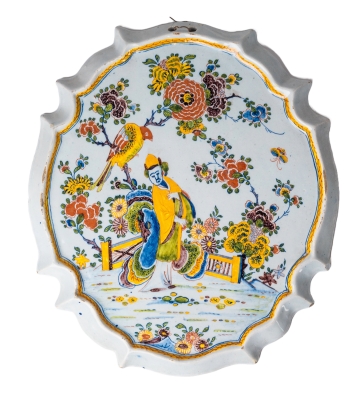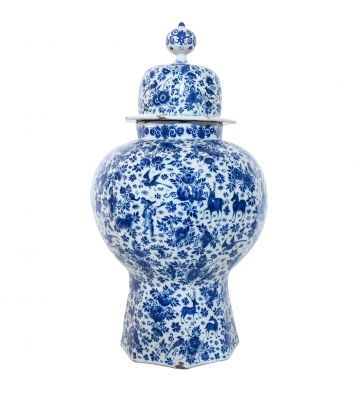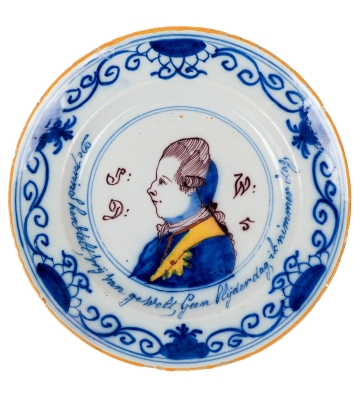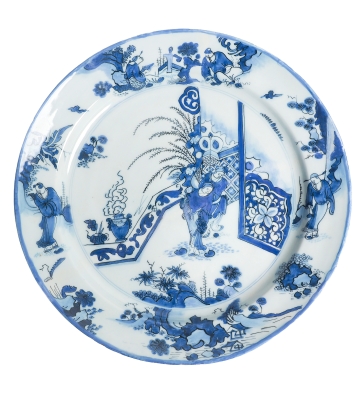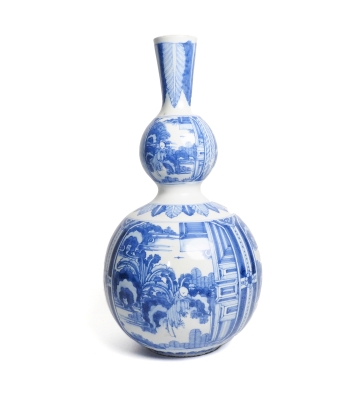The word "plaque" has its roots in Latin. It is derived from the Latin word "placa," meaning a flat, thin plate or slab. Antique plaques were especially made for decorative proposes. This particular plaque has a very unusual shape because the oval form has sharp ends looking like accolades. In this shape we can see the influence of the Rococo style. This style can be recognized by asymmetry and curved lines and had its main impact on interior decoration and applied art in Europe between 1730 and 1760.
The decoration is inspired by the Chinese Qianlong porcelain (1735-1796). The Long Eliza, crawl and peony flower are located in a typical Chinese fenced garden with rocks. In the second half of the 18th century these decorations became popular for especially the design of plaques. This can be explained by the influence of the Rococo style which typically displays lighthearted and elegant scenes.
The object has a striking color scheme. We can mainly see the red, yellow and deep blue but also a soft green, manganese (purple) and lighter blue. The use of this color scheme indicates a great craftmanship because of the time-consuming baking processes that was necessary to realize the result.
This plaque can probably be attributed to the pottery factory 'The White Star / De Witte Ster'. A similar decorated example has been auctioned in 2018, with the mark of this factory on her back (which is also a star)

Source: Rob Michiels Auctions, 2 March 2018 ‘European ceramics and decorative arts’ lot nr. 382.
Condition: good condition, minimal damage to the edge which is usual for Delft pottery. No defects or restorations.
Reference: A similar example but with another border is in the collection of Musée Ariana, Ville de Genève (inventory number; AR 2007-146-2). This work features on the cover of the book (and exhibition) of Anne-Claire Schumacher “La donation Clare van Beusekom-Hamburger, Faïences et porcelaines des XVIe-XVIIIe siècles” 2010.
For comparable examples see:
-Christies 13 November 2019, Live auction 17185 ‘The Collector: European and English Furniture, Ceramics, Portrait Miniatures & Works of Art’, Lot nr. 139.
-Christies 24 June 2020, Online auction 19597 ‘Arts from the kiln: ceramics through the centuries’, Lot nr. 18.
__________________________________________________________________________________________
Chinoiserie on plaques: décor and color.
From the mid the mid to late 18th century Delft chinoiserie plaques were being produced in larger numbers than before. We can often see exotic and colorful themes on pieces from that time with blossoming, prunus, peony, chrysanthemum branches, birds and Long Eliza’s with dancing boys in fenced gardens near gazebos or pagodas. The yellow color that is used often on the plaques described above is a color we do not see often on Chinese porcelain. The color yellow was ‘inherited’ by the Delft potters from the ‘old Dutch Majolica’ (this is one sides tin glazed and thicker earthenware produced by potters from Antwerp. They left Antwerp with their skills and knowledge in 1585 after the Spanish invasion and settled in places as for example Delft, Gouda and Haarlem). Dutch majolica makers used mineral ore-based colors originated in Italian maiolica of the Renaissance. For the Delft faience potter, who made more refined, thinner and luxurious pottery than the majolica, the use of bright colors was very difficult.
Source: R. D. Aronson “Dutch Delftware Plaques: A blueprint of Delft”, 2008, pp. 90 -91.

